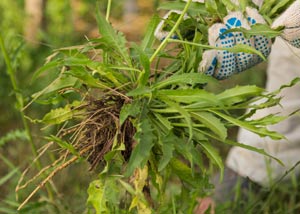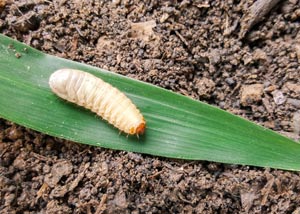Temperatures are on the rise and the days are slowly but surely getting longer; it’s clear that spring is coming quickly! We all know this season is an active time in the garden, but it is also an important time to give attention to our lawns. There are several tasks we should be performing this time of year to help our lawns transform into a lush, green oasis. Before we dive into what those tasks are, a quick word to the wise: no matter how many commercials you hear this spring, weed and feed products are not ideal in North Texas! The timing is almost always off for one or two of the components in the product (more on that later).
A Great Lawn Starts with Homework
The first step to a great lawn is an honest evaluation of what state your lawn is in.
Questions to ask include:
• What type of grass do I have?
• Is it a full, healthy-looking lawn?
• Is my lawn overrun with weeds?
• Do I have patches that look diseased?
• How much water should I give my lawn?
Answering these questions as part of your evaluation will go a long way towards growing healthy, green grass. Let’s address each question one by one.
The Grass is Always Greener… Or Is It?
If you are unsure of the type of grass you have, place some cuttings in a sandwich bag and bring them to your closest garden center. The experts there should quickly identify your grass type. The most common warm-season grasses in our area are St. Augustine, Bermuda, and to a lesser degree, Zosia. Knowing what you have is an important step as it will help dictate the types of products to use.
Understanding the general health of your current lawn is also important. If it looks spotty or displays a poor color, chances are you need to fertilize more regularly. However, if your lawn is lush and green, and your soil is healthy, you might not need to fertilize at all. In general, most Texas lawns require a fertilizer that is composed mostly of nitrogen. Nitrogen is the first of the three numbers that will appear on a fertilizer bag – the others being phosphorous and potassium. Too much phosphorous in the soil can lead to problems, so look for a product that has a high first number and a low second and third number. Many garden centers and hardware stores sell formulations labeled specifically for Texas lawns, which you should try to use. Each product is a little different, so follow the directions on the bag to determine how much fertilizer to apply.
Some organic gardeners like to apply a top dressing of compost about a quarter of an inch thick rather than use a typical fertilizer. Applying compost is a fine idea as long as it is done early in spring – a late application can burn the lawn. For best results when choosing a fertilizer for your lawn, conduct a soil test.
[button color=”blue” size=”medium” link=”http://soiltesting.tamu.edu/webpages/forms.html” icon=”” target=”true”]Texas A&M Soil Test[/button]
Knowing When to Fertilize
In general, fertilize twice a year – once in spring and again in fall. The timing of the spring application will vary by year due to our erratic weather in Texas. Spring fertilizer should not be applied until the grass is actively growing. I recommend waiting until the lawn is at least 50% green before fertilizing. If fertilizer is put down before the grass is actively growing, it is going to waste! The proper time during fall to fertilize the lawn is early to mid-September. You don’t want to wait too late as it can make your lawn grow and become susceptible to winter injury.
Getting weeds under control leads to a healthy lawn.  Use pre-emergent herbicides to kill the seeds that current weeds are producing. Most lawn weeds are annuals, which means they grow one season, produce seeds, and die. If you stop the weed seeds from sprouting, then you eliminate the weeds! Similar to fertilizers, apply herbicides in spring and in fall; however, they require a different application schedule than fertilizers. If it’s the right time for one, it’s probably not the right time for the other, which is why weed and feeds are not ideal.
Use pre-emergent herbicides to kill the seeds that current weeds are producing. Most lawn weeds are annuals, which means they grow one season, produce seeds, and die. If you stop the weed seeds from sprouting, then you eliminate the weeds! Similar to fertilizers, apply herbicides in spring and in fall; however, they require a different application schedule than fertilizers. If it’s the right time for one, it’s probably not the right time for the other, which is why weed and feeds are not ideal.
In general, apply spring pre-emergent products mid-to-late February or early March. In the fall, apply them early-to-mid October. There are a number of good products out there for this purpose. If you want to stick to an organic herbicide, the best pre-emergent product is corn gluten, which has shown to be effective in Texas. Make sure the one you choose is labeled for the type of grass you have. Once you have applied your pre-emergent, water it in as soon as possible, which assures it is effective and actually helps prevent it from washing away. If weeds are not a problem in your yard, you probably don’t need a treatment, but you can always start treating as soon as you notice them.
If you have St. Augustine grass, you could potentially struggle with brown patch disease, which is caused by the Rhizoctonia fungus. Brown patch disease creates brown circular-shaped lesions in your grass. Typically, they start forming in the spring and persist into summer. Left untreated, brown patch disease can spread throughout the yard. Use a fungicide labeled for brown patch disease to treat this common problem. Warning: brown patch usually needs to be treated multiple times before it can be controlled.
Bugs Damage Many a Lone Star Lawn
First on the list of usual suspects are grub worms.  Grub worms are white, fleshy larvae that live in the ground until emerging as beetles. They leave large brown patches in the lawn that often get confused with brown patch disease. No matter what type of lawn you have, grub worms can be a problem. It is easy to diagnose them as you simply dig into the affected area and if you have more than a handful, they are likely your culprit. If the problem gets too bad (i.e., your lawn displays several larva-infested brown patches) you might need to treat it. Look for a granular grub killer. It is recommended to treat the entire lawn and not only the affected area. Next on the hit list are chinch bugs. These little critters love the heat. They typically attack lawns at the edges first, often near a sidewalk. Chinch bugs are treated with an insecticide spray.
Grub worms are white, fleshy larvae that live in the ground until emerging as beetles. They leave large brown patches in the lawn that often get confused with brown patch disease. No matter what type of lawn you have, grub worms can be a problem. It is easy to diagnose them as you simply dig into the affected area and if you have more than a handful, they are likely your culprit. If the problem gets too bad (i.e., your lawn displays several larva-infested brown patches) you might need to treat it. Look for a granular grub killer. It is recommended to treat the entire lawn and not only the affected area. Next on the hit list are chinch bugs. These little critters love the heat. They typically attack lawns at the edges first, often near a sidewalk. Chinch bugs are treated with an insecticide spray.
Give Your Lawn a Drink
Watering your lawn on a proper schedule is probably the single most important aspect of Texas lawn care. Most lawns in the area require one inch of water a week. Here is a tip for figuring out how much water your lawn is actually getting when you water: on your next watering day, place open cans around your yard (an old bean can works fine). Water your lawn as you normally would, and when you are finished, simply measure how much water is in each can. Not only will you determine how much water you are giving your lawn, but you can also tell if some areas are receiving more water than others. I believe it is better to split up the one inch of water that is needed into two weekly applications. In other words, apply a half-inch of water twice a week to your yard.
Don’t forget to have fun and don’t the process overwhelm you. Getting your lawn on a good watering schedule, knowing when to fertilize, being aware of what problems could arise, and simply knowing how to handle them will get your lawn lush and green in no time. Happy gardening!
Drew’s Lone Star Lawn Schedule:
Late February through early March:
Put down spring application of pre-emergent herbicide to take care of weed issues. In a St. Augustine lawn, start monitoring for brown patch fungus now.
Mid-March through mid-April:
Start monitoring your lawn to know when to apply your spring fertilizer. Remember we don’t want to apply fertilizer until the lawn is at least 50% green.
Late April to early May:
Establish an irrigation program for your lawn. You need an inch a week and it’s best to split that up into two half-inch applications. This watering schedule will continue through summer and into late fall. Start monitoring lawns now for chinch bugs.
Early-to-mid September:
Apply fall fertilizer now.
Early to mid-October:
Put down the fall application of pre-emergent herbicide in lawns with weed issues.
November:
Irrigation can stop now until next season.